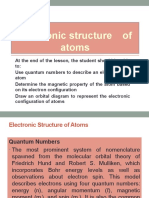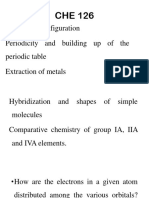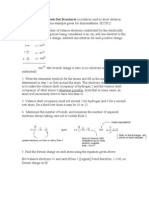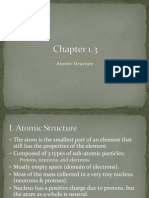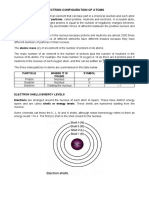Chem EOC1
Chem EOC1
Uploaded by
Kimberly MawhineyCopyright:
Available Formats
Chem EOC1
Chem EOC1
Uploaded by
Kimberly MawhineyOriginal Title
Copyright
Available Formats
Share this document
Did you find this document useful?
Is this content inappropriate?
Copyright:
Available Formats
Chem EOC1
Chem EOC1
Uploaded by
Kimberly MawhineyCopyright:
Available Formats
EOC # 1
Name ______________________________
Date ____________________
Period __________
Atomic Structure
An atom is made up of protons and neutrons (both found in the nucleus) and electrons (found in the orbitals surrounding the nucleus). The atomic number of an element is equal to the number of protons. If the atom is neutral then the atomic number also equals the number of electrons. A charge written in the upper right corner indicates that the number of electrons has been altered. The mass number (different than the average atomic mass) is the sum of the protons and neutrons.
Isotopes and Average Atomic Mass
Elements come in a variety of isotopes, meaning they are made up of atoms with the same atomic number but different mass numbers due to varying numbers of neutrons. A weighted average can be taken of the mass numbers of each isotope. The average is called the average atomic mass and appears in the box on the periodic table.
Cesium has three naturally occurring isotopes, cesium-133, cesium132 and cesium- 134. The percent abundance of each is 75 %, 20 % and 5 % respectively. Determine the average atomic mass of cesium. 133 X .75 = 99.75 132 X .20 = 26.4 134 X .05 = 6.7 132.85 amu
Nitrogen- 15 (+3) cation Mass Number 15 N +3 ion charge
Atomic #
7 protons 8 neutrons (15-7) 4 electrons (normally 7 but +3 means loses 3 electrons)
Complete the following table Atomic Mass # # # Element/Ion Number Number Protons Neutrons Electrons 1 H 1 H +1 12 C 7 Li + 35 Cl -1 39 K 24 Mg +2 74 As -3 108 Ag 108 Ag +1 33 -2 S 238 U
Determine the average atomic mass of the following elements. 1. 80 % 127 I, 17 % 126I, 3 % 128I ______________
2. 15 % 55Fe, 85 % 56Fe
_______________
3. 99% 1H, 0.8 % 2H, 0.2 % 3H
_______________
4. 95 % 14N, 3 % 15N, 2% 16N
________________
5. 98 % 12 C, 2 % 14 C _______________ EOC # 1 Name ______________________________
Date ____________________
Period __________
Electron Configuration
Electrons are distributed in orbitals with principal quantum numbers of 1 7, sublevels, (s,p,d,f), orientations (s has 1, p has 3, d has 5 and f and 7) and spin (two electrons are allowed in each orbital). Use your periodic table or the diagonal rule to place electrons into orbitals
Valence Electrons
Valence electrons are defined as the electrons in the largest energy level. They are always the electrons in the s and p sublevels, so the number of valence electrons can never exceed 8. You can determine the number of valence electrons from the electron configuration or by looking at the elements placement on the periodic table.
Draw the orbital notation for sodium: Sodium has 11 electrons: Orbital notation: __ 1s __ 2s __ __ __ 2p __ 3s
Carbon: 1s22s22p2 Largest energy level is 2 where a total of 4 electrons reside (look at superscripts). Therefore the valence is 4
Determine the number of valence each of the following has.
Element Fluorine Phosphorus Calcium Nitrogen Iron # Valence eElement Lithium Zinc Carbon Iodine Oxygen Barium Aluminum Hydrogen Xenon Copper # Valence e-
Electron configuration: 1s22s22p63s1 * remember Hunds Law
Draw both the orbital notation and write the electron configurations for: 1. Cl
2. N
Argon Potassium
3. Al
Helium Magnesium Sulfur
4. O
You might also like
- Learning Worksheet On Atomic StructureDocument8 pagesLearning Worksheet On Atomic Structureliza1207No ratings yet
- 4CH1 - 2C - Que - 20220118 IbrahimDocument28 pages4CH1 - 2C - Que - 20220118 IbrahimBakir JaberNo ratings yet
- Molecular Diagnostics 4ADocument6 pagesMolecular Diagnostics 4APaul LesterNo ratings yet
- Atomic Structure WorksheetsDocument5 pagesAtomic Structure WorksheetsYến Nhi LêNo ratings yet
- 3 Electronic Structure of Atoms 1Document28 pages3 Electronic Structure of Atoms 1Dummy BunnNo ratings yet
- Che 126 - (Prof Woods and Dr. Omoreghie's Part)Document541 pagesChe 126 - (Prof Woods and Dr. Omoreghie's Part)BishopNo ratings yet
- Atomic Structure and Periodic TableDocument51 pagesAtomic Structure and Periodic TableSoumyaa KumarNo ratings yet
- Chapter 1: Atomic Structure The Structure of The Atom A) Protons, Neutrons and ElectronsDocument21 pagesChapter 1: Atomic Structure The Structure of The Atom A) Protons, Neutrons and ElectronsTeneshwaran Muniandy MunusamyNo ratings yet
- Atoms Elements and CompoundsDocument14 pagesAtoms Elements and Compoundssaimtoor844No ratings yet
- BiochemDocument13 pagesBiochemLhay de OcampoNo ratings yet
- 2 Atomic StructureDocument53 pages2 Atomic Structure222483No ratings yet
- Rules For Writing Lewis Dot Structures (A Notation Used ToDocument9 pagesRules For Writing Lewis Dot Structures (A Notation Used ToannemichelleNo ratings yet
- Curs Chimie 1Document79 pagesCurs Chimie 1Onyx Tear100% (1)
- GRADE 9 ReviewerDocument7 pagesGRADE 9 ReviewerMa Belle Jasmine DelfinNo ratings yet
- Atomic Structure and Bonding MenuDocument85 pagesAtomic Structure and Bonding MenuSheryl Kalalo TumamacNo ratings yet
- 1.3 Atomic StructureDocument13 pages1.3 Atomic StructureLionel MigrinoNo ratings yet
- MEC281 Chapter 1 PDFDocument168 pagesMEC281 Chapter 1 PDFNasri JamaludinNo ratings yet
- ATOMic StructureDocument5 pagesATOMic Structuretalithaonkabetse723No ratings yet
- Unit 3 Notes - Atomic StructureDocument51 pagesUnit 3 Notes - Atomic Structurejessicalynn060190No ratings yet
- Periodic Table and Elements McgrawhillDocument46 pagesPeriodic Table and Elements Mcgrawhillapi-230328718100% (1)
- General Chemistry NotesDocument24 pagesGeneral Chemistry NotesGary MuhwatiNo ratings yet
- Fisika IntiDocument49 pagesFisika IntiDelovita GintingNo ratings yet
- Notes On Atomic StructureDocument4 pagesNotes On Atomic StructureJennifer Forbes100% (1)
- Elements, Compounds & MixturesDocument35 pagesElements, Compounds & MixturesSherazNo ratings yet
- Basic Chemistry NotesDocument81 pagesBasic Chemistry NotesRushikesh Navnath VarpeNo ratings yet
- Topic 2 - Atomic Structure IB Chemistry SLDocument30 pagesTopic 2 - Atomic Structure IB Chemistry SLHunter Bledsoe100% (3)
- Chapter 7Document22 pagesChapter 7stem25afNo ratings yet
- notes ch2&3Document55 pagesnotes ch2&3Khadija AlqudahNo ratings yet
- Ws 2Document4 pagesWs 2Claude CaduceusNo ratings yet
- Electron Configuration of AtomsDocument10 pagesElectron Configuration of AtomsDaniel BerryNo ratings yet
- A Level Physical Chemistry Year 1 Atomic Structure Structure and Bonding Amount of SubstanceDocument48 pagesA Level Physical Chemistry Year 1 Atomic Structure Structure and Bonding Amount of SubstanceWinnie Sheu100% (1)
- Atomic StructureDocument9 pagesAtomic Structurejackie.chanNo ratings yet
- Atomic Structure and Periodic TableDocument27 pagesAtomic Structure and Periodic TableTravel UnlimitedNo ratings yet
- Lesson 2: Elements in The PeriodicDocument61 pagesLesson 2: Elements in The PeriodicAngel FaythNo ratings yet
- Gen Chem 1 Handout q2 Weeks 2 4Document20 pagesGen Chem 1 Handout q2 Weeks 2 4Keyaru HealerNo ratings yet
- Atomic Structure: Earning UtcomesDocument25 pagesAtomic Structure: Earning Utcomessabrina_sarranNo ratings yet
- C6a Atoms and Elements Chem WebsiteDocument25 pagesC6a Atoms and Elements Chem Websiteapi-261462856No ratings yet
- Topics 1.4 - 1.6Document8 pagesTopics 1.4 - 1.6casperinrocNo ratings yet
- CH 8Document38 pagesCH 8MoNo ratings yet
- هندسة اشعاعDocument32 pagesهندسة اشعاعalrbabhsnNo ratings yet
- 01 AtomiDocument6 pages01 AtomiGenevieve PokuNo ratings yet
- Topic 1.1 Atomic Structure: 1.1a A Model of The AtomDocument5 pagesTopic 1.1 Atomic Structure: 1.1a A Model of The Atomking atikNo ratings yet
- Electron ConfigurationDocument30 pagesElectron ConfigurationShiela Dianne Caliwanagan100% (2)
- 1st Set of Exercises in Chemistry 1-1Document2 pages1st Set of Exercises in Chemistry 1-1bouazzasarahsectioneNo ratings yet
- Report AtomicTheory EditedDocument41 pagesReport AtomicTheory EditedCatherine Mae GarciaNo ratings yet
- Chem1 1 - Atomic StructureDocument5 pagesChem1 1 - Atomic Structureapi-247243068No ratings yet
- Final Notes 3.1.1Document10 pagesFinal Notes 3.1.1aprildazzleNo ratings yet
- Atomic Models - TheoryDocument109 pagesAtomic Models - TheoryDr-Walid Femtosecond100% (1)
- Chapter 2Document53 pagesChapter 2nishanthinnythesingNo ratings yet
- Atomic Structure (Chemistry O Level)Document50 pagesAtomic Structure (Chemistry O Level)Ping Hui100% (1)
- Atomic Structure CHEMISTRY A LEVELDocument48 pagesAtomic Structure CHEMISTRY A LEVELyasminzaherNo ratings yet
- Topic 2.1 - The Nuclear AtomDocument15 pagesTopic 2.1 - The Nuclear AtomJo-LieAngNo ratings yet
- Affan Telek - Chemistry Unit Test 1 Ver - 1Document14 pagesAffan Telek - Chemistry Unit Test 1 Ver - 1Affan TelekNo ratings yet
- 11U Unit 1 Student NotesDocument38 pages11U Unit 1 Student NoteschantelNo ratings yet
- AtomistructurenewDocument62 pagesAtomistructurenewetiosamiNo ratings yet
- Chemistry Form 6 Sem 1 01Document44 pagesChemistry Form 6 Sem 1 01Stephanie Tan0% (1)
- Concepts of Nuclear Medicine Volume I: Concepts of Nuclear Medicine, #1From EverandConcepts of Nuclear Medicine Volume I: Concepts of Nuclear Medicine, #1No ratings yet
- IOCAssignment-3 42Document5 pagesIOCAssignment-3 42Sanjit mourya Sanjit mouryavanshiNo ratings yet
- Quantum Dots Synthetization and Future Prospect ApDocument15 pagesQuantum Dots Synthetization and Future Prospect ApFaizan PashaNo ratings yet
- Bellow Installation Guideline For Expansion BellowsDocument5 pagesBellow Installation Guideline For Expansion BellowsPravin SatheNo ratings yet
- Invitrogen Price List 2016 (Duty Paid)Document253 pagesInvitrogen Price List 2016 (Duty Paid)Khristin AllisonNo ratings yet
- MS-100 2K ClearDocument6 pagesMS-100 2K ClearBen J.No ratings yet
- Determination of Stability Constants of PDFDocument15 pagesDetermination of Stability Constants of PDFAranya Roy ChoudhuryNo ratings yet
- (LC/MS) : Liquid Chromatography-Mass SpectrometryDocument24 pages(LC/MS) : Liquid Chromatography-Mass SpectrometryIndiraNo ratings yet
- Advanced Power Transformer Diagnostics Detection of Core Ground Issues 112 PaperDocument8 pagesAdvanced Power Transformer Diagnostics Detection of Core Ground Issues 112 PaperNisal AmarasingheNo ratings yet
- Reactions of Halogenoalkanes: Www. .CO - UKDocument15 pagesReactions of Halogenoalkanes: Www. .CO - UKcharlesma123No ratings yet
- Treatment of Gold-Bearing Solutions by Cementation With Metallic ZincDocument6 pagesTreatment of Gold-Bearing Solutions by Cementation With Metallic ZincInfernuzNo ratings yet
- General Standard: IPS-G-ME-100Document40 pagesGeneral Standard: IPS-G-ME-100Renalyn TorioNo ratings yet
- Amylase: Reagent Composition Interfering SubstancesDocument2 pagesAmylase: Reagent Composition Interfering SubstancesPaul TuveraNo ratings yet
- Chemistry Notes For Class 12 Chapter 9 Coordination CompoundsDocument14 pagesChemistry Notes For Class 12 Chapter 9 Coordination CompoundsAman KumarNo ratings yet
- Septiyanti 2019Document12 pagesSeptiyanti 2019Jose de PapadopoulosNo ratings yet
- General Chem-2 Midterm Exam QuestionnairesDocument10 pagesGeneral Chem-2 Midterm Exam QuestionnairesJeyger BuadlartNo ratings yet
- 186 681 2 PBDocument10 pages186 681 2 PBalexigonzalezNo ratings yet
- ENVS 1301-01 Learning Guide Unit 1 Introduction HomeDocument2 pagesENVS 1301-01 Learning Guide Unit 1 Introduction HomehomepoetNo ratings yet
- Catalogue KhumicDocument11 pagesCatalogue KhumicFertilizantes OrgánicosNo ratings yet
- Chol 2018Document10 pagesChol 2018astriNo ratings yet
- Sub: Biology: Chapter: Breathing & Exchange of GasesDocument5 pagesSub: Biology: Chapter: Breathing & Exchange of GasesRamkrishnahari RaskarNo ratings yet
- Corrosion MCQ 6TH SEMDocument6 pagesCorrosion MCQ 6TH SEMrajpoothalimasafNo ratings yet
- MYP - 1-Lab - Equipment - PPTDocument53 pagesMYP - 1-Lab - Equipment - PPTvandana giriNo ratings yet
- Identification Test PDFDocument3 pagesIdentification Test PDFKM Strong-FBNo ratings yet
- LAB #3-Filtration and EvaporationDocument5 pagesLAB #3-Filtration and EvaporationshadowNo ratings yet
- Metabook 5844Document69 pagesMetabook 5844john.cabrera917No ratings yet
- Chapter 13 Exam Style AnswersDocument5 pagesChapter 13 Exam Style Answerssafwaanraqeeb786786No ratings yet
- Determining Chemical Resistance of Thermosetting Resins Used in Glass-Fiber-Reinforced Structures Intended For Liquid ServiceDocument5 pagesDetermining Chemical Resistance of Thermosetting Resins Used in Glass-Fiber-Reinforced Structures Intended For Liquid ServiceQUALITY MAYURNo ratings yet
- Summative Test 4 in Science 6 Q1Document2 pagesSummative Test 4 in Science 6 Q1geramie masongNo ratings yet





